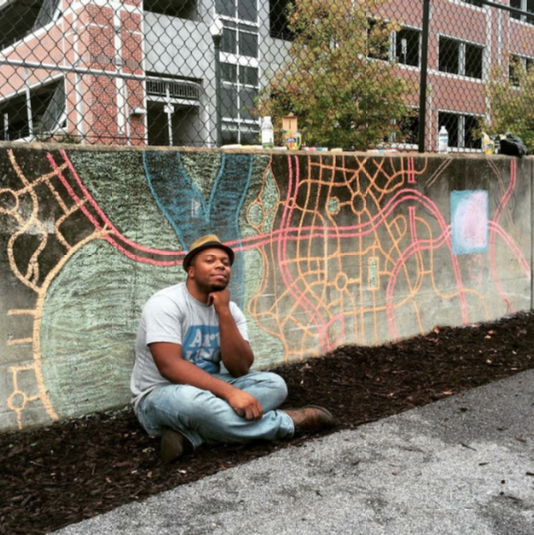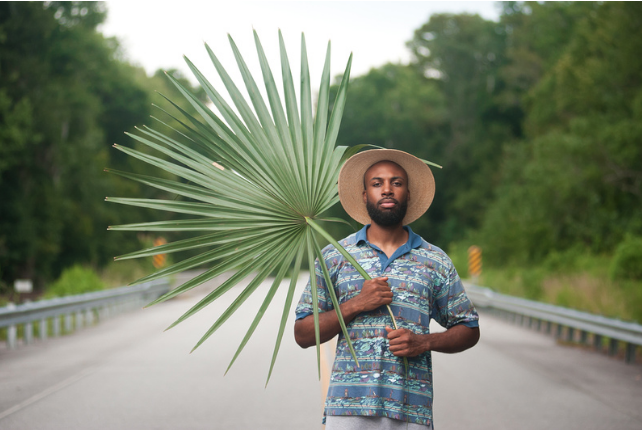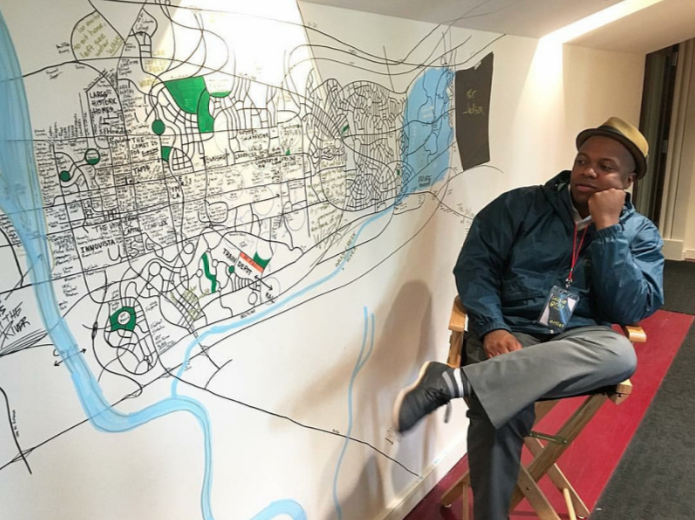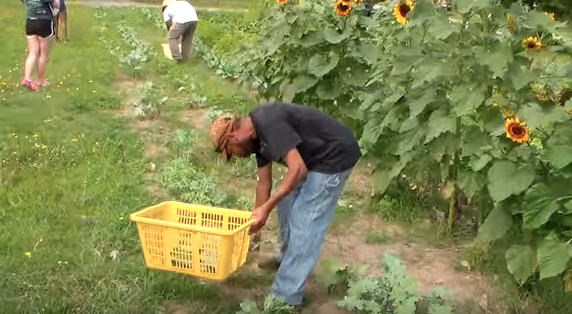Michael Dantzler maps the interconnectedness of Eastover, South Carolina
Michael Dantzler is a full-time photographer, creative, and budding community organizer living in his rural hometown of Eastover, South Carolina, a town of only about 800 people that is predominantly African American.
He has been working on projects related to community development in his hometown for several years now. One of his main creative projects is producing a community newsletter for Eastover to keep local people informed and connected, and he also runs the town’s social media profiles. Prior to that, he started the Eastover Community Garden, a place for members of the community to work collectively to grow food and also for the community to gather.
Dantzler also has maps on the brain, and has created several map projects in Columbia, South Carolina, the state capitol located just 35 minutes from Eastover.
“Maps are my first love out of everything since I was a child,” he explains. Two early childhood experiences led to his interest in and fascination with maps: First, he lost his father when he was six years old, and all he remembers of him is that his hobby was building model railroads of mostly rural towns. Then, when Dantzler was seven or eight years old, his mom got lost while they were driving on the interstate. He was so upset that he cried, and he vowed never to get lost again. That’s when he started drawing maps.

“I was drawing maps from memory. I was the youngest child and there weren’t a lot of kids to play with, so I just drew maps in my spare time. Through high school I probably accumulated at least 500 maps.”
At the time he had no idea that his own hobby had anything to do with city planning or what that even meant, but as he got older he began to understand the significance of maps—not just their technical significance, but the ways in which maps can be used to represent important periods of cultural and historic significance in a community.
Then, in 2016, the Indie Grits Film Festival commissioned Dantzler for a photography project documenting South Carolinians affected by the historic 2015 floods as part of a series covering the aftermath of the floods featuring wide-ranging works from multiple artists. The photography project evolved into a map that incorporated elements of photography, storytelling, and gardening—all different passions of Dantzler’s that all coalesced into a narrative about the floods and the resilience of life.
That map project led to a few more, including a chalk map for the University of South Carolina School of Music and another called the Columbia Map of Infinite Connectedness (CMIC), a project of the Leadership Columbia Class of 2017 in partnership with One Columbia for Arts and History and the City of Columbia.
“The Columbia Map of Infinite Connectedness is just to show we’re all connected,” Dantzler explains. “Every shape is connected to another shape. We’re not isolated people.” The map shows the interconnectedness of humans, land, and water, and also indicates population density, movement, and development through the size and color of its shapes. Red and white lines on the map head away from downtown Columbia and run off the map, leading to his hometown of Eastover.

He is passionate about bringing some of that creative energy from the city to his small, rural town. “This is home for me. I don’t want it to die.”
He remembers that when he was growing up, Eastover was a “jumping town,” but he has seen a decline over the last 30 years. “One of the indicators for me was that there used to be a locally owned grocery story in town, but it closed down 15 years ago or so. Now the only thing remotely close to it is a Dollar General.”
That was part of the reason why, in 2014, he decided to start a community garden. With support from the University of South Carolina, Dantzler was able to use a plot of land in the middle of downtown Eastover on the same block as the library, fire department, and town hall. He used water from the Eastover Fire Department to water the crops, and did educational programming in the garden in partnership with the Richland Library Eastover.
“There was a lot of interconnectivity,” he says. “I didn’t have any funding for equipment or anything; I just had the land and permission to use it. My main goal was to try to get community members involved.”
He knew that food was something people can easily connect over, and a lot of people in the county of Richland already grew their own food—”rich land” literally referring to the rich, fertile ground. But small farmers in the area have been put out of business over the last 20 years, and for a town that is almost entirely Black, there weren’t many Black farmers left.
Which was why, in 2015, Dantzler shot a photography series called “Gardens for Equilibrium” in the Eastover garden. “I wanted to show people of color in the garden, being at one with nature, with sunflowers all around them.”
Eventually he had to let the garden go; he would get help from a few people here and there but most of the work had fallen on him. He says he would love to do it again in the future, and has otherwise remained very active in the Eastover community with other projects.

He started producing a community newsletter to keep people informed about things going on in Eastover after attending a town hall meeting where there was a lot of community turnout because of some misinformation over a social services building. He suggested a newsletter to improve communication and increase public engagement with town government, so the town government contracted him to be the one to do it. He writes and edits the newsletter, including pertinent information for residents to know and also going around town to find local stories to tell. He is also the town’s photographer and social media manager.
“I’ve started bringing Eastover into 2019,” he laughs. “I’m trying to promote the town and connect the dots. The town used to be more diverse 40 years ago, but like many inner city areas there was a white flight and that’s part of reason Eastover has declined. There’s a big separation between the town itself and the people who live outside of it—the unincorporated portion of the county is about 50 percent Black and 50 percent white, but the town itself is 98 to 99% Black. That’s one of the issues I’m facing is trying to fix that broken connection and trying to show our interconnectivity, because a divided people is a people set up for failure. I want to try to mend those fences.” He added by way of underscoring his point that Dylann Roof, the convicted shooter of the Emanuel African Methodist Episcopal Church shooting in Charleston, South Carolina, in 2015, was from Eastover.
Now the town wants Dantzler to also start a crime watch, which he feels a bit conflicted about—crime is something he certainly wants to eliminate because if people don’t feel safe, they won’t come, but there has also been a disproportionately negative narrative in the media about crime in Eastover that isn’t totally accurate either. Besides, as a Black man in the South, he also feels a bit hesitant to fully trust law enforcement. But he also sees this as a potential opportunity to shift the town’s negative narrative by taking ownership of it.

“The town is not full of crime; we just have a few bad people that make the town look bad,” he says. “When there are good things happening, you don’t really hear about it, but our town is full of good people. I feel like it may be necessary [to do this] just to take ownership and try to steer the narrative of the town from being a crime-ridden ghetto to being a more hospitable, friendly community. The perception of the news can make a whole area look bad.”
While Dantzler describes himself first as a photographer and second as a musician, he has also become a writer and storyteller in the community. He is currently working on a story project with the South Carolina Arts Commission through their Art of Community—Rural SC project.
He started as a photographer for the project, which inspired him to do even more work in his town. The newsletter was the start of something more sustainable with more longevity than the community garden, and now he is working on the “Eastover Story Project” for the Art of Community—Rural SC project.
“[This project] is all about bringing arts to rural communities to stimulate economic growth, development, or any type of community redevelopment,” he explains. “I’m going out there and seeking stories, interviewing people in Eastover who know the town’s history, have good stories themselves, or are local business owners. These stories will be in the state archives in the future.”
One of the first stories he wrote for this series was on the very active horseshoe culture in town—as in, the backyard game of horseshoes.
“I grew up here and didn’t even know about it but it’s huge here,” he says. There are two horseshoe teams in town that compete against each other “just like the Mets and the Yankees.” These teams play against other rural towns, and one of them just went to a championship. When there’s a game, upwards of 300 people show up to watch.
“It’s one of those things that happens in communities that I didn’t even know about and just blows my mind, like I found a treasure in my own backyard,” he says fondly.

Through his work with the South Carolina Arts Commission, Dantzler hopes to learn more about how to be “at the table” with available resources and grants, so that he can do more work within his community and make whatever project he wants to happen a reality.
With that in mind, he’s also been attending a lot of conferences lately, including the Rural Arts & Culture Summit, to learn more about different creative engagement concepts and strategies.
“I learn a lot at different conferences from people who are father down the line than me,” he says. “One of the things I’ve learned from these conferences that I do in Eastover now is work on being more present in my community. Now I try to do simple things like walking around talking to people and trying to build rapport. Just showing my face more and having these conversations builds trust; I went from being the stranger guy taking pictures to ‘Michael, the newsletter guy who’s looking out for us.'”
He says being an ambassador with the Art of Community—Rural SC has modified the lens through which he views his community.
“It’s really shown me how to see treasure in my own community through creative placemaking and asset mapping,” he says. “Now I look around and I see so much potential. We already have a city grid. Some buildings are abandoned but they can still be used. There are a lot of talented people from this area, but they leave go to the cities. I wish I could entice more young talent to move back. That’s one of my biggest goals: convincing young talent to come back to their rural town.”

He knows it’s a hard sell because for many, it means taking a substantial pay cut. But with Eastover being so close to Columbia, that higher-paying city work is still accessible to those living in town, and he thinks in 10, 20, or 30 years urban sprawl will reach all the way to Eastover.
“I hope people who live here will be the pioneers in redeveloping their own community ahead of that sprawl,” he continues. “The problem with gentrification is when there is a disregard of the community and people living there. I’m trying to sound the alarm for residents who already live there—you all need to get it together and rebuild our community rather than having Starbucks come in and do it. I really want the people to be first in redeveloping their community ahead of gentrification.”
Dantzler doesn’t think that all “gentrification” is inherently bad, but the City of Charleston as an example of gentrification gone wrong.
“You never want a city to stop growing, but the problem is affordability: People who work downtown can’t afford to live there. I feel like developers—the retail, the residential, the people that do have the money—need to be more sensitive. But I know I’m preaching to the choir, and that’s why I focus on the people. People that live in a community are more sensitive to what they develop rather than someone who is just in it for the money. Each community has its own heartbeat, soul, and rhythm, and no one can voice that better than the people who’ve been there for years.”
His hope is to see Eastover have a thriving downtown that becomes a vibrant hub of activity.
“I would love to see my town really thriving again with a lot of small businesses,” he says. “I want the people here to be the pioneers. I have no problem with big businesses coming in, but I really want small businesses to be the first part of development.”
Lead image: Dantzler in front of his chalk mural at USC’s School of Music.

(1) How do you like to collaborate?
I like to collaborate with like-minded people. There’s got to be a focus, and as long as my town benefits—I’m very picky about that and selective in who I work with.
(2) How do you start a project?
I feel like the best way to get to know something is to go see it in person. When it comes to Eastover, just going outside, being present, seeing the cars pass by, smelling the air—face-to-face interaction is important.
(3) How do you talk about your value?
Pay your damn artists what they’re supposed to be paid, just like any other job! I could be an accountant, an engineer, or a janitor—I feel like as an artist, as a creative, we have a purpose. However we do things, it’s just as valuable as any other job. We shouldn’t have to convince people so much. Sometimes people look at artists like we’re an elite tribe or a separate people; I try to make art sound like it’s not this elite thing where you can only talk about it at a cocktail party with a bowtie on. I try to break that mold and try to be an everyday person. There are a lot of artists that don’t even promote their art because they don’t think it’s art, but I try to break that barrier. Everything you see is art and was made by a creative person. That car you love? An artist designed that. I just believe in people getting paid for what they do, just like any other job with all the work and time we put in.
(4) How do you define success?
My American intuition says that since we’re in the land of capitalism, I gotta get paid. Outside of capitalism, if money wasn’t a factor, I think just being a part of a community is enough. I wish that was just it: just being able to do the work I need to do without having to worry about making a living.
(5) How do you fund your work?
Most of my work is done as an independent contractor—I work for various companies as a photographer, and also for the town as the newsletter and social media guy. I would like to do more grant-funded things, but I’m trying to get beyond the everyday hustle so I can sit down and actually write grants. I would love to get to that point where I don’t have to worry about everyday surviving and I make enough money to get to next week and have enough time to breathe. A big challenge right now is to transition from survival mode to more long-term-planning. In my lifetime I want to be paid for what I do; I don’t want to be broke. I know the money is out there; it’s just about having the right narrative and conversations and relationships to get there.
